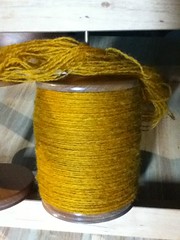 By Amelia © December 21, 2010
By Amelia © December 21, 2010 There has been a loooong silence here -- in part because I am working through a large commission job, 10 pounds of Romney roving, spun to 1600 ypp 2-ply (think fingering weight 2-ply), for a tapestry weaver using all local product and preparation. Yep, local sheep, local mill, local spinner (that's me!) Very cool, but not very "Ask The Bellwether"-able unless you want notes on how to spin consistently through that much fiber -- and maybe, you do. I'll have to work on that one.
The picture at the top the post is one of the recent bobbin-fulls.
So, while I work on that, here's some information I recently posted in the Hansen Crafts group on Ravelry to aid another spinner. Perhaps you will find it useful as well.
How you plan to use the fiber can influence the prep used as much as the type of fiber.
One guideline is to comb all fleeces with staple over 3 inches and card all fleeces with staple under 3 inches -- I’ve heard that many times, but to be honest I don’t pay much attention to it. Some of the reasoning is that it’s hard to handcard longer fibers, and hard to comb shorter fibers. But hard never stopped me. More reasoning is that longer staple fibers are very well suited to worsted preparations, which combing is, and shorter staple fibers are very well suited to woolen preparations, which combing is.
If I want the smoothest possible yarn, I know I need to either comb or flick-prep the locks, to keep all the fibers perfectly aligned. That said, I also know I can hand-card but roll the carded fiber to keep fibers aligned rather than the standard rolag-roll that puts them all in a spiral. And, my drum carder can help keep fibers pretty much aligned if I feed them all in lock-straight -- so it’s a very productive 80%-right solution.
If I want the airiest possible yarn, I know I need to handcard or drum card the fibers, or spin from a picked cloud. These preps can randomize the direction of the fiber -- spinning from the fold will do something similar, as the fold introduces the desire for the yarn to open-up and push its elbows out in the yarn. Drumcarding, I’d feed the locks in sideways similarly to get lots of air and direction in the fibers in the batt.
I’ve noticed different mills produce fairly different rovings; my local mill with Patrick Green equipment produces a truly random roving -- that's the mill that prepared the roving spun into yarn shown at the top of this post; while roving from Zeilinger’s is much more organized, almost sliver (not top, since different lengths of fiber are included in it).
Oh, and -- my Merino (and Cormo -mmmmm Cormo!) fleeces go to Morro Fleece Works. I can’t say enough good things about how nicely the Morro mill processes fine wools.
~~~~~
Related posts:
What fiber preparations are there?
Where can I get my fleece processed?
~~~~
© December 21, 2010 by Ask The Bellwether, posted at http://askthebellwether.com/blog
